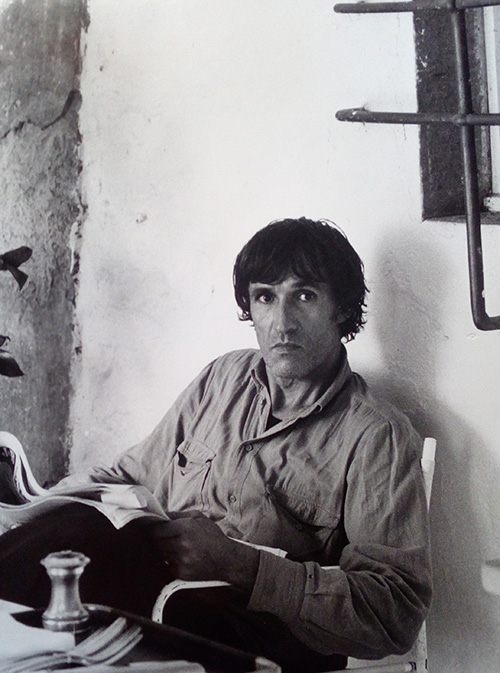1982
November 14, 20171984
November 14, 2017After a lengthy convalescence, AB began his new life in his home in the Monteverde district on the Janiculum. He took on a third regular assistant, the young Florentine artist Andrea Marescalchi. An excellent designer, down to 1990 Marescalchi was kept busy copying magazine covers in pencil. That the genre increasingly fascinated AB, who saw it as representing all kinds of information as well as standing for the inexorable passing of time.
With the help of “Bobo” Marescalchi and his other assistants, AB began to turn out a considerable number of works in ballpoint (on paper) or in embroidery (on fabric). In the ballpoints, they consisted of sentences presented in the previous decade as embroidered squares, written in block letters or concealed in the interplay of commas and renewed in their color combinations. Examples were Amazzare il tempo, Sragionare/in lungo/e/in largo (blue/green/red/black) or the later Uno/nove/otto/quattro (blue/red/green/black) in 1984.
In the case of the embroideries, since he had never broken off his contacts with occupied Afghanistan, AB gradually received by mail those Mappe he had commissioned in ’79 without being able to take delivery of them personally. He now mailed out new Mappe to be embroidered.
These were sheets of linen which he fully prepared at his studio in Trastevere, indicating the geographic pattern and the colors of the flags and inscriptions to run along the borders, with texts that stand out forcefully as a challenge to the military occupation: “Alighiero and Boetti at Kabul Afghanistan in 1983 the progressive vanishing of habit,” or “Alighiero and Boetti at Kabul Afghanistan in 1983 leave the certain for the uncertain and vice versa.” The production of the Mappe continued in this way up until 1985. His intermediary was no longer Dastaghir, whom he lost touch with when he fled from occupied Kabul. It was now Salman Ali, his assistant in Rome, who was still in contact with his family. Some of whom were at Jagori in Afghanistan, while others had sought refuge on the borders of Pakistan.

Alighiero Boetti, 1983, photo by Milton Gendel
Besides the Mappe, AB had a certain number of what he called “embroideries of letters” made in Afghanistan. These were large colorful compositions with phrases in block lettering. These tapestries “of a thousand colors,” as more than one embroidered text reads, are true stories to be read, vertically or horizontally, like Addizione and Sottrazione, which he dated ’83 and ’84.
AB was happy to return to work and was deeply aware of the thread uniting his now mature work: the centrality of time and the wisdom of letting it flow. This was embodied, as always, in works of different kinds: images from magazines, surfaces covered with hatching in ballpoint, embroideries and maps.
In a conversation with Bruno Corà, after the previous autumn’s convalescence, he said:
“…If you swim against the current in a river, after a while you’ll come to a tributary and have to face the dilemma whether to choose to go right or left. Instead, if you go downriver, following the current, you’ll never have to choose. I would like keep following the current and never choose… My works in ballpoint are concentrates of time, an enormous dilated time span. The embroideries, too. And I’m pleased that for certain embroideries I sometimes have to wait up to five years. Strangely I have the patience to wait for them, or rather I don’t wait for them, they arrive when they arrive.”
As he resumed work, the exhibitions multiplied, both in Italy and abroad. Among the most significant was a brilliant solo exhibition at the Galleria Pieroni in Rome in February, which exhibited four Pier Piets in different colors; I Mille Fiumi più lunghi del mondo, the large tapestry (version in black and white) with an embroidered transcription of the names and lengths of the thousand rivers contained in the book Classifying the thousand longest rivers in the world; and finally some variants (in ballpoints of different colors) of Clessidra Cerniera e vice versa.
Other solo exhibitions followed in northern Italy. AB enjoyed staying at his friend Lisa Ponti’s home on Via Randaccio in Milan.
In March, he had a solo exhibition at Franz Paludetto’s gallery in Turin, where he displayed a single work, the white and green version of I Mille Fiumi più lunghi del mondo, which had just arrived from Kabul.
In April, at the PAC in a two-man show with Carlo Accardi, he exhibited together for the first time the two versions (in black and white and white and green) of the tapestry I Mille Fiumi più lunghi del mondo. The other works presented were of historical importance: I sei sensi of 1973 in eleven panels and Aerei of 1977, a large triptych (175 × 300 cm) with hatching in blue ballpoint.
The group exhibitions included: “Trenta artisti italiani, 1950–1983” in the church of San Samuele in Venice; “Arte a Torino dal 65 all’83” at the Kölnischer Kunstverein in Cologne; an exhibition organized for the tenth anniversary of the Galleria di Massimo Minini in Brescia.
In November, a group exhibition at the Galleria Pieroni brought together the three old friends: AB, Sol LeWitt and Giulio Paolini. On display were Boetti’s early drawings of magazine covers under the title Novembre 83, a selection of eighteen images of magazines published that same month. The following year AB exhibited this panel together with Ottobre 83 and Dicembre 83, a quarterly collection that heralded the large sequences based on whole years (Anno 1984, Anno 1986, Anno 1988, Anno 1990). Of this work, AB commented in 1984:
“In that month, there were millions of images. Today, perhaps there are only a hundred. Then there will only remain this faded copy once colored.”

